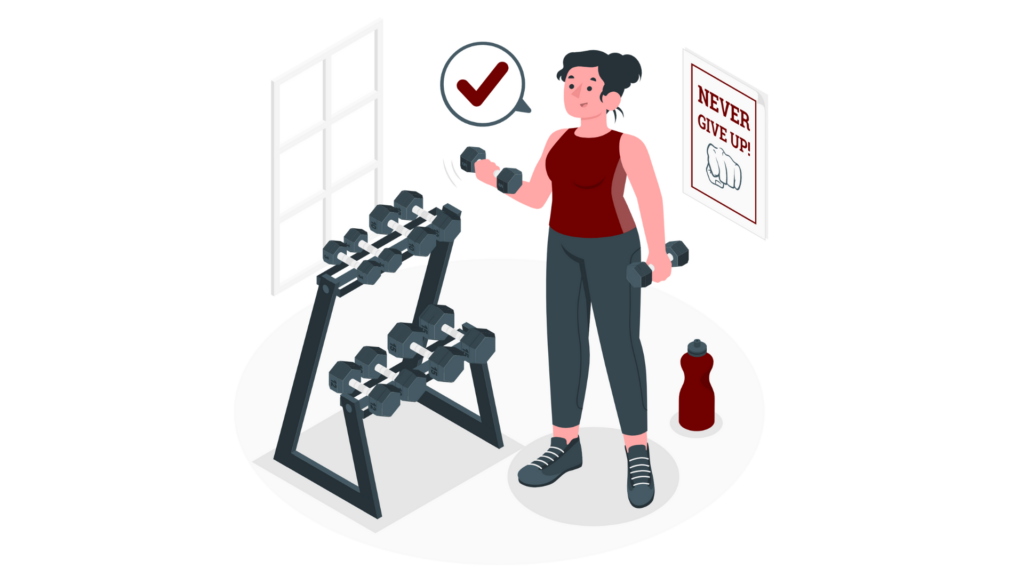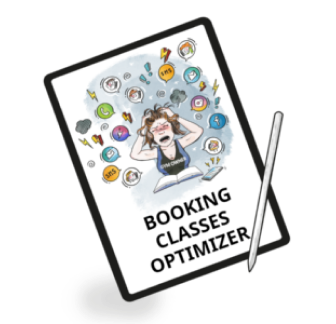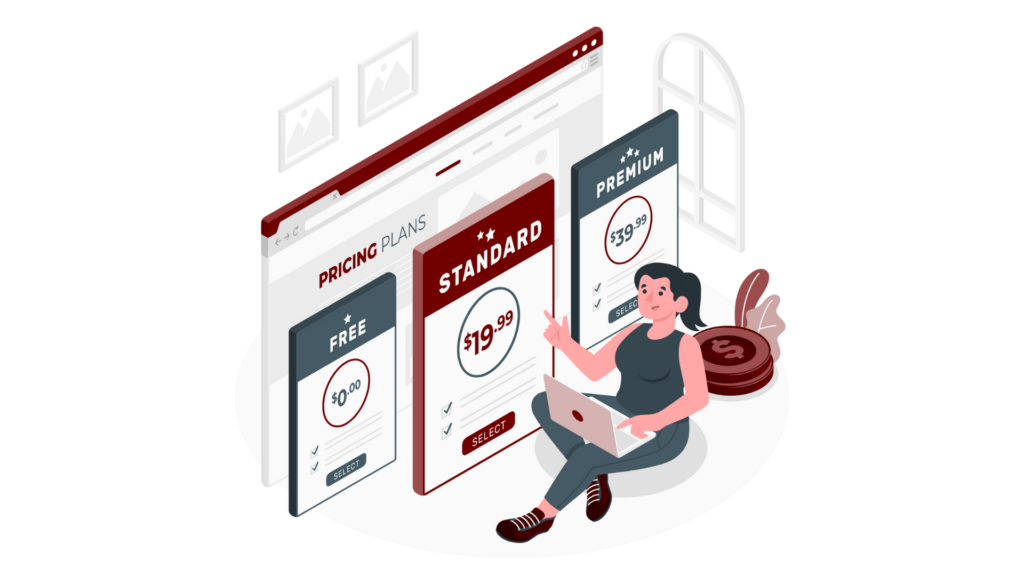How to make money in the gym industry? In 2024, the financial success of a gym hinges on more than just monthly membership fees. The importance of diversifying revenue streams cannot be overstated.
More people prioritizing their health and fitness, gyms have become pivotal centers not just for exercise, but for community and holistic wellness. This surge in demand has paved the way for gyms to explore multiple avenues to increase profitability.
By broadening the range of services and offerings, gyms can not only enhance their financial stability but also enrich the customer experience, making them indispensable in the daily lives of their patrons. How to increase the profitability of a gym? From personal training and specialized classes to integrating technology for personalized fitness journeys like perfect gym management software, the opportunities to expand are vast.
In this context, we will explore 20 innovative ways gyms are capitalizing on the booming fitness industry to maximize their total revenue potential in 2024.

Where do gyms make the most money?
How to make money in the fitness and gyms business? There are three main ways in which gyms make the most money. First and foremost, income at a gym can be earned through:
- selling passes and entrance fees
- giving lessons by personal trainers
- selling additional products or services
These three elements are the main source of a gym’s livelihood. Of course, there are many more additional options for raising money, but without these, no gym will be successful.
Gym membership fees
The primary source of income for the gym is membership fees. It is thanks to them that one earns…. although not always the most! The Health & Fitness Association (IHRSA) reports that, on average, you pay $59 per month in 2023 for a gym membership card in the U.S. The cheapest memberships are, of course, those of large fitness clubs and gyms that operate on a franchise basis. This steady revenue stream is bolstered by automatic withdrawals from bank accounts, ensuring that gyms like Planet Fitness can rely on consistent income from members, even those who may not frequently use the gym facilities.
However, this doesn’t mean that you can’t compete with them. On the opposite – many Americans prefer to use small, boutique gyms or dedicated clubs. And it will be up to you to decide on the pricing strategy you apply to your place.
Each membership type can be tailored to different market segments, accommodating the varied lifestyles and financial abilities of potential gym goers. Offering a range of memberships not only meets diverse consumer needs but also increases the potential revenue streams for the gym.

What types of gym memberships can be sold?
Offering a variety of gym membership types can help cater to different customer needs and preferences, potentially broadening your client base. Here are some common types of gym memberships that can be sold:
- Standard Monthly Membership – it’s the most common type, allowing unlimited access to gym facilities and equipment during normal operating hours.
- Annual Membership – clubmates pay for the year in advance, often at a discounted rate compared to monthly fees.
- Family Membership – offers membership benefits to multiple family members at a reduced rate per individual compared to separate memberships.
- Off-Peak Membership – discounted rates for members willing to access the gym during less busy hours, usually mid-morning to mid-afternoon.
- Student Membership – reduced rates for students who present valid student identification.
- Senior Membership – discounted rates for older adults, promoting fitness and wellness in the senior community.
- Corporate Membership – businesses buy memberships in bulk for their employees, often at a discounted rate. This encourages fitness while potentially improving overall employee health and productivity.
- Day Passes – allows non-members to access the gym for a single day. This is useful for travelers or those wanting to try out the gym before committing.
- Week or Month Trials – a temporary membership that lets potential long-term members try out the facilities and services before making a longer commitment.
- Class-Only Memberships – these kinds of memberships provide access only to group classes and not to the rest of the gym facilities.
- Premium Memberships – higher priced memberships that include additional perks like personal training sessions, access to special areas (e.g., sauna, steam room), and other exclusive services.
- VIP Memberships – it offers the highest level of service and access, including specialized personal attention, exclusive products and services, and access to invite-only events.
- Pay-As-You-Go Membership – members pay for each visit, which is a flexible option that can attract people who use the gym infrequently.
- Online Memberships – access to virtual classes and training sessions, which can be a standalone option or an add-on to physical gym access.
- Hybrid Memberships – combines in-gym and online workout options, providing flexibility for members to train both at the gym and from home.
- Community Membership – special rates or times reserved for community groups, like local clubs or non-profit organizations, encouraging community engagement.
What to keep in mind. Gyms make money from membership through different strategies and business models. By introducing different types of monthly subscriptions, gyms generate a steady cash flow by allowing customers regular access to the facility in exchange for a fee. In addition, by offering passes for shorter periods of time or one-time entries, gyms also attract people who are unwilling or unable to opt for a long-term commitment.
Sometimes, gyms employ a strategy of withdrawal fees before the end of the contract, which provides an additional source of revenue. By offering flexible pricing and a variety of payment options, gyms can effectively manage their finances while ensuring that customers can choose the fitness experience that is most suitable for them.
Personal training
Gyms, aiming to provide a comprehensive service to their clients, are increasingly investing in personal training offerings as a form of personalized support in achieving fitness goals. By employing qualified personal trainers, gyms not only offer their clubmates a personalized approach to training, but also generate additional revenue. This is very important and provides additional.
Personal training is an attractive option for people looking for effective support in achieving specific fitness goals, such as losing weight, increasing strength or improving fitness.
In addition, gyms can charge both customers with membership passes who choose personal training as an additional service, and non-club members who use personal training on a one-time fee basis. In this way, personal training becomes not only an effective tool in achieving fitness goals, but also a significant part of the strategy for generating additional revenue for gyms.

Extra Goods and Services
Gyms, in an effort to provide an absolutely comprehensive and attractive offering to their customers, can employ a variety of strategies to monetize by offering additional services. In addition to traditional monthly subscriptions, gyms can generate additional revenue by selling personal training, which provides personalized support in achieving fitness goals. But you already know that!
Additionally, group classes are a popular form of activity, allowing people to work out in a motivating atmosphere, which translates into greater customer loyalty and higher turnover. Gyms may also offer wellness services, such as massages, saunas or hot tubs, which are a great compliment to a workout. Partnering with nutritionists or diet specialists is another option that allows gyms to expand their offerings to include comprehensive healthy lifestyle support.
Retail sales of various types of goods, such as dietary supplements, meetings with nutritionists, long-distance cooperation with nutritionists or physiotherapists are also great. Some gyms are also investing in the nutrition business – running their own bar or area where healthy snacks can be purchased. According to IHRSA, fitness clubs make a lot of money precisely from additional retail sales – the amounts in the US reach up to $2,600 a month.

With a variety of service offerings, gyms can cater to a variety of customer needs and maximize the earning potential of their business. An excellent investment is additional classes in the form of group exercises, for example, which allow you to increase the profitability of your fitness industry. You then don’t have to focus only on selling passes, but offer something more to those who already have one.
What facilities are worth investing in?
- A court for any sport – such as basketball, soccer or racquetball.
- Tennis court – although its maintenance is not cheap, it allows new members who have a passion to join the gym.
- Personal training: Individual training sessions conducted by qualified personal trainers that are personalized and tailored to the client’s needs and goals.
- Group classes, especially such as fitness classes such as aerobics, Zumba, cycling, or more specialized classes such as Pilates or yoga. These classes provide guests with a social and motivational workout atmosphere.
- Specialized health and fitness courses, such as first aid courses, training in workout technique, or trainer certification courses.
- Weight loss and healthy lifestyle programs – gyms may offer nutrition programs, dietary consultations and support for weight loss and improving overall health.
- Coaching sessions may address not only physical training, but also the mental and motivational aspects of achieving fitness and healthy lifestyle goals.
- Special fitness classes for children, such as dance, agility classes or programs to introduce them to an active lifestyle from an early age.
20 ways for gyms to make money in 2024
Now is the time to look at different ways to maximize your company’s potential revenue. There are a whole host of options, especially if you will be using gym management software. However, there are other ways to increase your gym’s revenue.
From navigating the intricacies of gym insurance to optimizing account management systems, the quest for profitability requires a keen understanding of emerging trends and innovative strategies. In this guide, we outline 20 ingenious ways gyms can improve their financial health. You’ll learn about the opportunities as different tie-ins help you move away from selling gym equipment, among other things, to differentiating services to attract a diverse clientele, and streamlining processes for efficient payment solutions for gyms.

These range from traditional methods like buying passes to more advanced strategies like personal training, weight loss programs and retail sales of fitness products. Want to discover innovative ways to increase your gym’s profitability? Learn about our proven post-gym ways to increase your bank balance long-term!
1. More membership fees with online bookings
Use online booking features of gym management software to get more clubmates. Best online system is the way to efficiently increase the profitability and incomes of your business.
Guests increasingly expect the convenience of online booking when choosing a gym or fitness studio, and businesses that fail to provide this feature may lose potential guests to competitors who do.
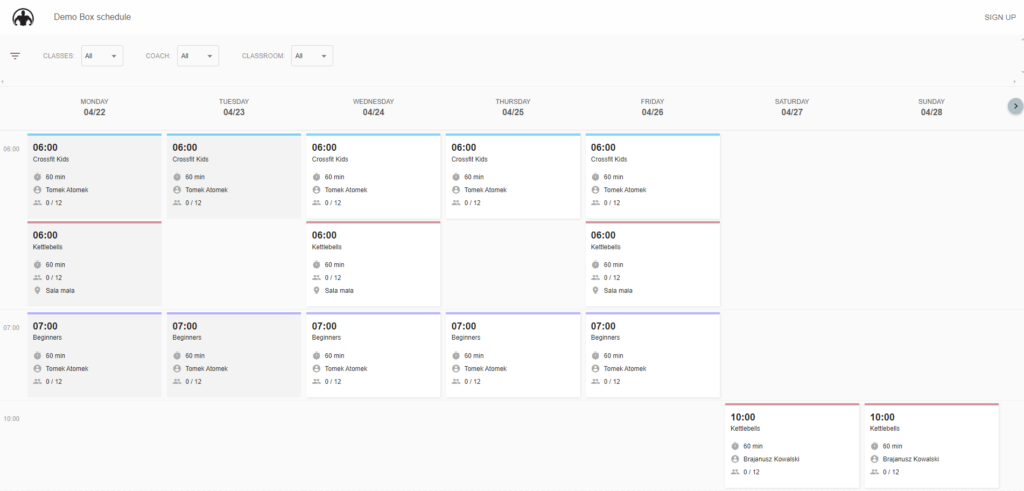
With online booking you get:
- Convenience: Online booking systems allow clients to schedule their workouts at their convenience, anytime and anywhere, without the need to call or visit the gym in person
- Efficiency: Streamlining the booking process online reduces administrative tasks for gym staff, such as manually scheduling appointments or managing phone calls.
- Improved Client Retention: Offering online booking options can increase client satisfaction by providing them with greater flexibility and control over their fitness regimen.
- Access to Real-Time Information: Guests can easily view class schedules, instructor availability, and facility availability in real-time through the online booking platform.
2. Think about selling personal training services to increase total gym revenue
As a gym owner you can offer one-on-one coaching sessions for an additional fee. Use the right pricing strategy and personal training packages: they should be cost-effective for guests while generating profits for your business.

Personal training sessions typically command higher fees compared to group classes or general gym memberships. By selling personal training packages, fitness businesses can significantly increase their average revenue per client, maximizing the value derived from each individual customer.
3. Implement “Waitlist” when signing up for fitness classes to avoid losing customers
By actively managing waitlists and offering reserved spots to waitlisted consumers in advance of class times, fitness businesses can reduce no-show rates and minimize revenue losses associated with empty spots. Proactive communication and waitlist management strategies help ensure that classes are fully utilized and revenue opportunities are optimized.
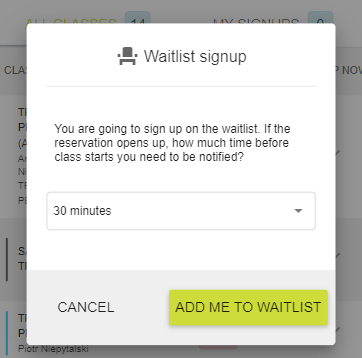
With well implement “Waitlist” you can increase gym’s revenue and get:
- Maximized class attendance: A waitlist ensures that classes are fully utilized by allowing interested clients to join a queue when a class is fully booked. When someone cancel his participation in the class, the next person will enter that place.
- Improved customer experience: By offering a waitlist option, fitness businesses demonstrate responsiveness to client demand and provide an inclusive experience for all customers, regardless of initial availability.
- Enhanced retention: Implementing a waitlist helps prevent consumers from feeling frustrated or disappointed when unable to secure a spot in their desired class.
- Increased client engagement: Waitlisted clients remain engaged with the fitness business and are more likely to participate in future classes or events.
- Upselling opportunities: While on the waitlist, guests may explore alternative class options or consider upgrading to premium services, such as personal training or specialty workshops.
4. Always have a full room at your fitness classes with “Booking/Scheduling” option
Offering an online booking and scheduling option for fitness classes provides numerous benefits for both fitness businesses and their clients. Implementing an online booking and scheduling option for fitness classes offers numerous benefits, including:
- convenience for guests,
- maximized class attendance,
- improved client experience,
- reduced administrative burden,
- enhanced communication, data insights,
- competitive advantage in the market.
By embracing technology like WodGuru and meeting client expectations, fitness businesses can drive revenue growth, increase customer satisfaction, and achieve long-term success.
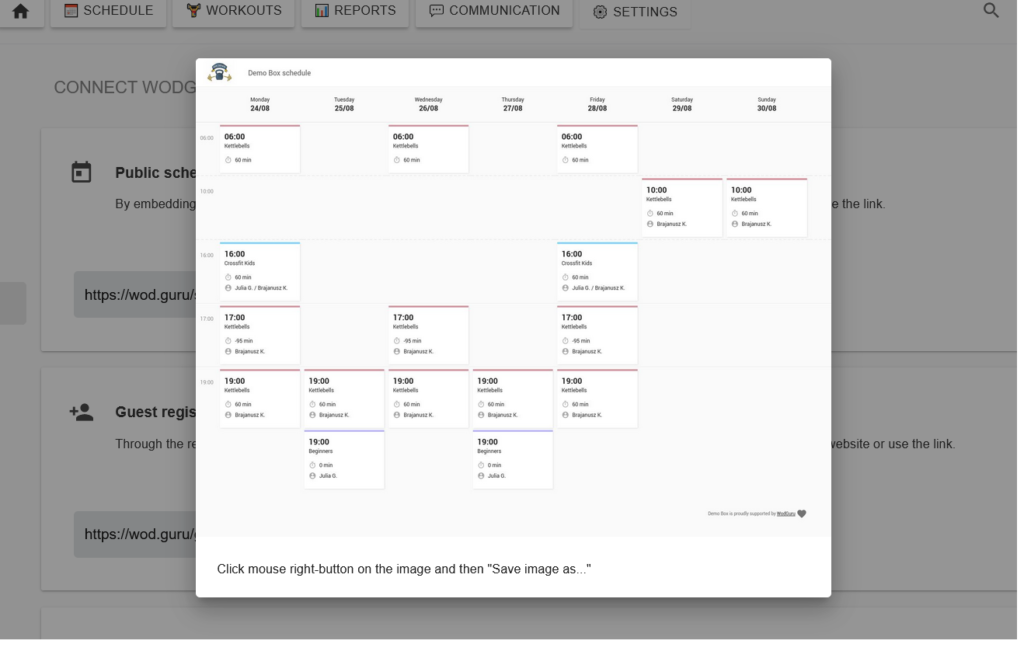
5. Think about selling online training programs
It’s time to consider delving into the realm of selling online training, especially when considering factors like insurance and investments. By offering subscription-based virtual workouts and live streamed classes accessible to both members and non-members, you can tap into a broader market and potentially earn more revenue in the long haul.
Hybrid memberships, which blend in-person and online access, cater to diverse clientele and accommodate varying preferences and schedules. Moreover, providing on-demand video libraries allows clubbers to engage in workouts at their convenience, regardless of location or time zone differences.

Investing in online training not only expands your reach to the whole country but also ensures a sustainable business model that can thrive beyond geographical boundaries.
6. Automate your work using a gym management system
One simple way to increase long-range revenue in a company is to invest in the right and helpful gym management software. Be on the right track! Automating administrative processes, such as managing passes, registering new or long haul clients or scheduling classes, allows staff to focus on customer service and delivering quality service.
Automating your work with a gym management system offers numerous benefits for fitness businesses:
- Making online reservations for classes and managing training schedules.
- Monitor revenue or debt from various sources, such as membership fees, passes, or additional services.
- Analyze customer activity and trends in customer behavior.
- Evaluate facility utilization and occupancy of individual zones or training rooms.
- Better utilization of human resources through effective staff scheduling.
- Adjusting customer activity offerings to meet customer demand based on data analysis.
- Increasing customer engagement.
- Personalized notifications on customer accounts about new classes, promotions, events or other helpful information.
- Customized training plans and support from personal trainers on the platform.
- Improved customer experience.
- Get your gym guests an easy access to information about classes, trainers and facility amenities.
- Fast customer service through automated processes.

7. Control access to the gym facility through electronic cards or mobile apps
Implementing access control to the gym facility through electronic cards or mobile apps is a way to get more money. This allows you to do away with having a receptionist, reducing the need to paying more employees. This is one of the factors that can determine the success of your gym.

This is the solution that WodGuru provides numerous benefits, including:
- enhanced security,
- more clients convenience,
- flexible access options,
- improved member management,
- remote access management,
- member accountability,
- competitive advantage in the market.
Leveraging modern access control technology, fitness businesses can provide a safer, more convenient, and more secure environment for their clubbers while also optimizing facility operations and driving long-term success.
8. Make difference – gain more income by selling products in the gym and online
Maximize your income potential by offering products for sale both in the gym and online. By selling gym-branded apparel and accessories, you can capitalize on the loyalty and pride of your members, who are often willing to pay for merchandise that represents their fitness community.
Partnering with fitness brands for a share of profits allows you to expand your product offerings and tap into established customer bases. Additionally, setting up an automated online store makes it easy for clubmates and online shoppers alike to purchase branded gear with minimal hassle.
Diversifying your revenue streams in this way, you can significantly boost your income and make a noticeable difference in your bottom line.

9. Inform club members about expiring passes
Thanks to gym management software, club members can now stay informed about expiring passes, leading to potential savings and increased revenue for the business. Leveraging automated notifications from WodGuru, gym owners can effectively manage pass expiration dates, ensuring that clubbers are aware of upcoming expirations well in advance.
This proactive approach allows members to determine the best course of action, whether it’s renewing their pass, upgrading to a different membership tier, or taking advantage of promotional offers to extend their membership. By keeping clubmates informed and engaged, gym owners can maximize revenue opportunities and drive growth, especially during key quarters where renewals and upgrades play a significant role in financial figures.
Additionally, these notifications provide valuable data insights that can inform targeted marketing efforts aimed at retaining existing members and attracting new ones, further contributing to the bottom line of the business.
10. Introduce the possibility of online payment for passes
Online payment option for fitness passes is a way that can revolutionize how customers interact with gyms and fitness centers. By enabling potential clients to sign up, renew, and even cancel their memberships from the comfort of their homes, facilities not only streamline their operations but also enhance user satisfaction.

This flexibility leads to increased customer retention as individuals can manage their memberships according to their specific needs without the hassle of in-person visits. It gets you more gym income.
Moreover, online payments can significantly boost enrollment rates, as the ease of signing up can lead to more spontaneous decisions to join, particularly during promotional periods or when new fitness trends arise. Overall, integrating online payment methods for fitness passes offers gym profits as a seamless, efficient, and user-friendly way to attract and maintain a robust client base.
11. Link your website to your gym management system
Linking your website directly to your gym management system can yield… more money for your company, especially in terms of boosting sales and streamlining operations. By integrating these platforms, your gym can continue to capitalize on the seamless interaction between your online presence and internal systems.
For the company, this integration can be a game changer, allowing for better tracking of sales trends and member behaviors, which can guide strategic marketing and operational decisions.
In the upcoming quarter, with this integration, the gym can expect to see a notable increase in total revenue due to several factors:
- Increased conversion rates: Easy access to sign-up and payment options directly on the website encourages more visitors to convert into members.
- Enhanced member experience: Clubbers enjoy a smoother, more efficient interaction with your services, from signing up to booking classes and facilities, which improves retention rates.
- Streamlined administration: Reduces the need for manual entries and checks, cutting down on administrative costs and errors.
- Data-Driven decisions: Provides valuable insights from user interactions on the website, enabling targeted promotions and improvements.
Linking your website to your gym management system is an investment in the future growth of your company, ensuring that you continue to generate more money and improve operational efficiency, quarter after quarter.
12. Post an always up-to-date fitness schedule on your website or Facebook page
Want to get more money? Keep investing and be a different gym than others. Take advantage of the sales opportunities WodGuru gives you.

Keeping your fitness schedules up-to-date and easily accessible, you not only meet the immediate needs of your members and employees. You also continue to drive your marketing efforts, creating a dynamic and responsive fitness environment, which will 100 percentage translate into profit for your business.
Here are some specific benefits:
- Improved member satisfaction: Clubmates appreciate the convenience of accessing real-time schedules anytime, anywhere, which enhances their planning and utilization of your facilities.
- Increased efficiency: Employees can manage their time and responsibilities more effectively when they have a predictable schedule that adjusts in real time to changes.
- Enhanced marketing: Regular updates keep your online presence active and engaging, drawing more attention to your offerings and potentially attracting new members.
- Resource optimization: Real-time scheduling helps manage the availability of space and equipment, reducing bottlenecks and ensuring a better distribution of resources.
13. Communicate with your club members with personalized campaigns
Invest in marketing such as communicating with your club members through personalized campaigns. You can do it the easy way – using a gym management system. Personalization allows you to tailor your marketing messages based on the individual preferences and behaviors of members, enhancing engagement and increasing the likelihood of continued membership. This targeted approach ensures that clubmates receive relevant information that resonates with their fitness goals and interests, making them feel valued and understood.
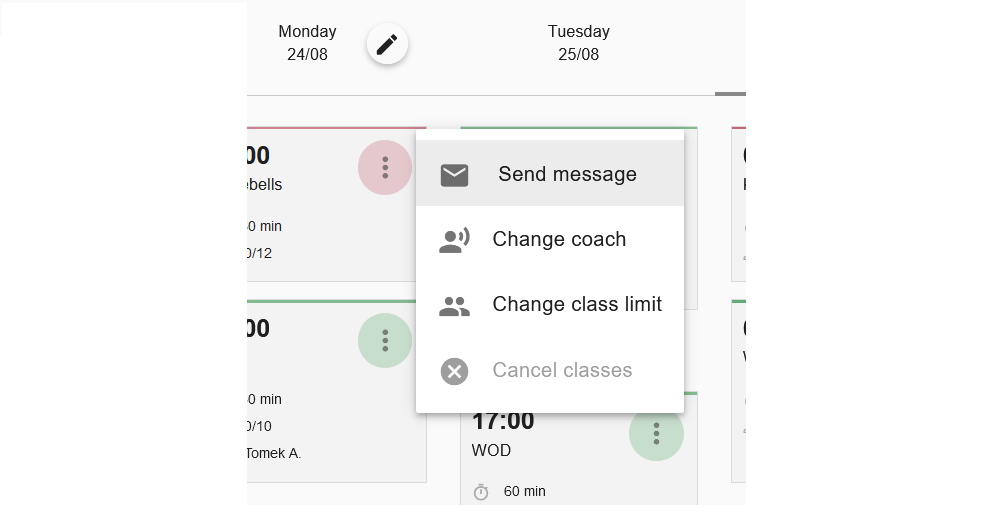
Investing in personalized lead marketing campaigns not only helps in retaining current members but also boosts the efficiency of acquiring new ones.
- Personalized communications can reduce the likelihood that members feel disconnected and cancel their memberships, as they see regular reminders of the value your club offers.
- Tailored messages are more likely to be read and acted upon, leading to higher engagement rates with your promotions and events.
- Greater marketing ROI – you can achieve it by targeting members with messages that are relevant to their interests, you waste less effort on uninterested parties and improve your return on investment in marketing.
- Personalized interactions foster a stronger connection between your club and clubmates, encouraging loyalty and word-of-mouth referrals.
14. Get bigger total revenue by renting your gym space
Renting space in a gym can significantly increase total revenue by maximizing facility utilization. This strategy allows you to tap into new sources of income beyond regular fees and class payments.
How can such revenues be achieved? Figure out that a gym can be rented out during off-peak hours to personal trainers looking for a professional environment for their clients, or to local organizations looking for a venue for wellness events or team-building exercises. Additionally, a portion of the gym can be offered as event space for health fairs, fitness competitions or educational workshops related to health and wellness.

By diversifying the use of space, you not only create more revenue-generating opportunities, but also expand your presence in the community and attract potential new clubmates. This approach makes efficient use of every square meter of your facility, ensuring that your resources are fully utilized to contribute to your overall revenue.
15. Take advantage of rotational programs – conduct workshops and events
Taking advantage of rotating programs by conducting workshops and events can greatly increase the value and appeal of the facility. Changing the topics of these programs on a regular basis keeps the content fresh and attractive to both new and existing members.
Such a way to make more money can include hosting specialized fitness workshops, nutrition seminars or a “60-day challenge to increase your strength by 15 percent.”

Such events not only provide members with valuable knowledge and skills, but also foster a community atmosphere, encouraging interaction and camaraderie among participants. Additionally, these programs can attract a wider audience, including those who may not be interested in a traditional gym membership, but are looking for specific health and wellness opportunities.
Implementing a dynamic schedule of events and workshops not only adds variety to the offerings, but also keeps clubbers excited and engaged, potentially increasing retention and attracting new customers via panto mail.
16. Make knowledgeable business decisions based on data
A robust gym CRM system can report a wealth of data, including member attendance patterns, class popularity, retention rates and revenue streams. This data can identify which classes are most frequently attended and at what times, helping to optimize scheduling and staff allocation.
Additionally, analysis of enrollment and dropout trends can provide insights into customer behavior, allowing you to effectively adjust marketing strategies and retention efforts.
Example? With specific data, such as information on how many customers sign up for specific classes, you can build your gym’s schedule based on what clubbers like best. This will keep your employees from having empty rooms, and you’ll have more total revenue.
Using this comprehensive data, you can make informed decisions that not only improve your gym’s day-to-day operations, but also contribute to its long-term growth and success.
17. Introduce penalty for no-shows at fitness classes
Imagine someone canceling their participation in a class at the last minute. The room is booked, the group is assembled, but the class won’t be profitable because there won’t be enough clients. What then? Unnecessary stress and nerves.
You can avoid this by introducing a penalty for not showing up to class. Inform the club members about such a solution – this way you will have control over the profitability of the business. In addition, customers under pressure from the “penalty” will sign out early if they can’t take a class, and someone from Waitlist then can step in to take their place.

The accrual of the absence penalty is done directly in the management software – WodGuru. In order for a club member to sign up for the next meeting, he or she will have to pay the penalty to continue practicing. You will gain a kind of insurance and certainty of business profitability!
18. Provide customers with access to gym information from mobile app
Providing customers with access to gym information through a WodGuru mobile app can significantly enhance their fitness experience. Developing a proprietary gym app with premium features allows clubbers to interact seamlessly with your services.
Such an app could offer a range of functionalities, including booking classes, managing membership details, and accessing a library of workout videos. Moreover, the app can include subscription-based services that deliver personalized workouts tailored to the user’s fitness goals and progress tracking features.
See how to tailor the WodGuru mobile app to your needs:

These premium options not only enrich the user experience but also create an additional revenue stream for the gym. Subscription fees for these personalized features ensure that members receive value from their investment while enabling the gym to continuously improve and expand its digital offerings. This approach not only meets the modern demand for digital fitness solutions but also strengthens member engagement and retention.
19. Get student and senior discounts
By offering special pricing, gyms can attract students and seniors who may find the cost of a standard membership prohibitive, but are often able to attend classes during off-peak hours. This not only allows the facility to fill up during hours when it is typically underutilized, but also maximizes the use of space and resources.

Setting up special class times dedicated exclusively to students and seniors can further optimize the use of the facility. This is often a better and more profitable option than rooms for rent when the gym is not fully filled.
These classes can be tailored to the specific needs and preferences of these groups, increasing their enjoyment of the gym. Such targeted scheduling and pricing strategies not only attract more clubbers , but also foster a sense of community, encouraging long-term loyalty and increasing word-of-mouth referrals, which are invaluable for sustained revenue growth.
20. Sell passes and products available at the bar online
Healthy food, accessories such as sportswear, and towels can be purchased through an online platform added to your gym site. From now on, members will be able to easily purchase sports kits, bidons, towels, or other sports accessories.

What can you sell online to earn more?
- Small items like yoga mats, resistance bands, foam rollers, and dumbbells are popular among those who also workout at home or want their own equipment for hygiene reasons.
- Online training programs, workout videos, and e-books related to fitness and health can be a great source of passive income that members can access anytime.
- Fitness-related accessories such as water bottles, gym bags, heart rate monitors, and fitness trackers are always in demand.
- Offering gift cards for membership time or store credit can be an excellent way for members to introduce friends and family to the gym.
You can also continually upgrade and take advantage of other options, such as subscribing to nutrition plans or online dietary advice. This is particularly appealing because it provides your gym members with seamless, regular access to healthy food options directly related to their workouts. They can access everything through a single WodGuru app.
Key takeaways
- Encouragement to innovate and experiment with different revenue streams to find what works best for your gym.
- Remember to diversify your offerings. Bet on a variety of services that will increase variety and make your bank account grow, and you will gain relevance in the fitness industry.
- Subscriptions and gym passes are just one way to efficiently monetize your business. You can’t forget about the others, which in percentage terms will also translate into a continuous increase in your company’s profitability.
- Offer fitness products, but also nutritional supplements, protein bars, nutritional drinks and even sportswear. All of these can add to your overall income.
- Implementing gym management systems, such as WodGuru, can streamline your processes and make your operation more efficient, contributing to increased profitability.
- Organizing fitness events, contests or workshops can attract new customers and increase engagement of existing members.
- Effective marketing campaigns can attract new customers and increase brand awareness, leading to greater overall revenue.
- Establishing partnerships with local businesses, schools or sports clubs can bring in additional revenue streams through affiliate programs and member discounts.
FAQ
How do 24-hour gyms make money?
24-hour gyms capitalize on the constant availability they offer to a diverse population, making them a convenient option for people with non-traditional working hours. The primary revenue for these gyms comes from membership fees, which are structured to attract a large volume of members and ensure a steady income stream.
These gyms also typically see a boost in revenue during the first and last quarter of the year when new memberships spike due to common fitness-related resolutions and seasonal promotions.
The strategic location of these gyms, often in high-traffic areas, helps to maintain high visibility and attract new leads. Additionally, operational costs such as rent are carefully managed, often determined by the size and accessibility of the property.
Which gyms make the most money?
Gyms that typically generate the most revenue are large, well-established chains with multiple locations across various regions. These gyms leverage their broad brand recognition and extensive networks to attract a large membership base. They also benefit from offering a wide range of services including state-of-the-art fitness equipment, group classes, personal training, wellness programs, and additional amenities like pools, spas, and on-site health cafes.
Furthermore, these successful gyms enhance their profitability through ancillary services such as merchandise sales, nutritional supplements, and branded fitness apparel. The combination of diverse revenue streams, extensive membership options, and upscale services positions these gyms to outperform others in the fitness industry in terms of profitability.
Is owning a gym good money?
Owning a gym can be financially rewarding, but it comes with many challenges and requires significant upfront investment and strategic planning.
The initial costs for setting up a gym, including leasing a space, purchasing equipment, and obtaining necessary licenses, can be substantial. However, with a strong business model and effective management, a gym can provide a stable source of income.
For many owners, the financial success of a gym also aligns with personal passions for fitness and wellness, making it not just a potentially profitable venture but also a fulfilling one.
Is it worth spending money on gym?
Deciding whether it’s worth spending money on a gym membership involves weighing the benefits against the cost. It is often worth the investment if you utilize it frequently and take advantage of the facilities and services offered. It encourages a commitment to maintaining physical health, provides a variety of exercise options, and fosters a community environment that can keep you motivated. However, it’s essential to assess your personal goals, preferences, and financial situation to make the right choice for you.
How many members does a gym need to be successful?
The number of members needed for a gym to be successful varies widely based on several factors, including the gym’s size, location, operating costs, membership fees, and business model.
Consider the capacity of the gym. A small boutique gym will have a different capacity compared to a large commercial gym. It’s important that the number of members does not exceed the gym’s capacity to serve them effectively, as this can affect member satisfaction and retention.
Ultimately, the specific number varies, and successful gym owners often focus on maximizing member retention and satisfaction, as acquiring a new member can be more costly than retaining an existing one. Regular evaluation of financial metrics and member feedback is essential to adapt and thrive in the competitive fitness industry.

